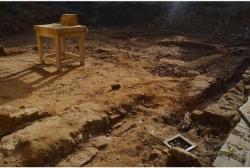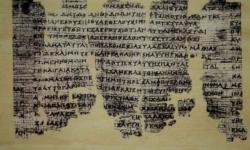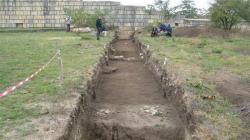INSTITUT SUPERIEUR D'ANTHROPOLOGIE
INSTITUTE OF ANTHROPOLOGY
ONLINE COURSES / COURS A DISTANCE
WINTER TERM : JANUARY 2016
REGISTER NOW
ROYAUME UNI –  Northampton - Medieval ruins have been discovered in the grounds of Delapre Abbey. The 15th century stone structure was located beneath part of a courtyard, where the new commercial kitchen is to be located. "The archaeologists believe it was either the eastern side of the abbey cloister, or the remains of an infirmary detached from the main building. "During their investigations they discovered a type of decorative tile used extensively during the period, which helped date the find. "There was also a circular well which would have been linked with the first floor of the building, rather an innovation for the time." The find also includes a basement structure, lined throughout with clay as a waterproofing medium.
Northampton - Medieval ruins have been discovered in the grounds of Delapre Abbey. The 15th century stone structure was located beneath part of a courtyard, where the new commercial kitchen is to be located. "The archaeologists believe it was either the eastern side of the abbey cloister, or the remains of an infirmary detached from the main building. "During their investigations they discovered a type of decorative tile used extensively during the period, which helped date the find. "There was also a circular well which would have been linked with the first floor of the building, rather an innovation for the time." The find also includes a basement structure, lined throughout with clay as a waterproofing medium.
http://www.northampton-news-hp.co.uk/Medieval-structure-discovered-Delapre-Abbey/story-27983046-detail/story.html?
CANADA – Oshawa - Did you know that Oshawa has been the site of several archaeological excavations, two of which unearthed evidence about some our earliest settlers? The first archaeological excavation to happen in Oshawa began in the late 1960s, when evidence of an aboriginal settlement was unearthed on the property of Howard McLeod at the corner of Thornton and Rossland roads. The excavation was lead by the University of Toronto and volunteers from the Oshawa Historical Society assisted with the actual digging. The items unearthed show that this was once the home to a Lake Ontario Iroquois village dating to about 1450 CE. The village consisted of approximately five longhouses that were surrounded by a high, protective wall called a palisade. The second archaeological site related to aboriginal inhabitation was located at the corners of Taunton and Grandview Road North. This site, known as the Grandview Site, actually dates earlier than the McLeod site, as it was inhabited around 1400 CE. Much like the McLeod site, this was once home to a large Lake Ontario Iroquois village. This village was larger, consisting of approximately 12 longhouses. Unlike the McLeod site, there was no palisade surrounding this village. Combined, these two excavations tell us the story of Oshawa’s earliest known settlers. Items unearthed show us that the people who lived here in 1400 CE were agriculturalists who grew maize, beans, sunflowers and tobacco. They were also hunters who relied heavily on deer and fish to provide necessary protein. Combined, the two excavations unearthed more than 29,000 artifacts. The items excavated range from a variety of sizes of projectile points, pipes and pipe bowls and pottery shards. Several of the pottery shards are what show the relationship between the Grandview and McLeod sites. Pottery found at both sites has a very unique “slip” or glaze on them. These are the only two sites with this unique type of glaze and this shows that the people who settled at the Grandview site, moved to and settled at the McLeod site.
http://www.oshawaexpress.ca/viewposting.php?view=8616
GRECE –  Derveni - One of the most valuable finds of the Archaeological Museum of Thessaloniki, the Derveni Papyrus, has recently been included in UNESCO’s “Memory of the World” programme, the first Greek registration in this list. The Derveni Papyrus is of immense importance not only for the study of Greek religion and philosophy, which is the basis for the western philosophical thought, but also because it serves as a proof of the early dating of the Orphic poems offering a distinctive version of Presocratic philosophers. The text of the Papyrus, which is the first book of western tradition, has a global significance, since it reflects universal human values: the need to explain the world, the desire to belong to a human society with known rules and the agony to confront the end of life. The papyrus roll was found in Derveni, near Thessaloniki, in 1962 carbonized among the remains of the funeral pyre upon the slabs of Derveni Tomb A. It survived due to the fact that it was carbonized by the funeral pyre and was thus not affected by humidity. It is dated to around 340-320BC and it is a copy of an older version written at the end of the 5th century BC.
Derveni - One of the most valuable finds of the Archaeological Museum of Thessaloniki, the Derveni Papyrus, has recently been included in UNESCO’s “Memory of the World” programme, the first Greek registration in this list. The Derveni Papyrus is of immense importance not only for the study of Greek religion and philosophy, which is the basis for the western philosophical thought, but also because it serves as a proof of the early dating of the Orphic poems offering a distinctive version of Presocratic philosophers. The text of the Papyrus, which is the first book of western tradition, has a global significance, since it reflects universal human values: the need to explain the world, the desire to belong to a human society with known rules and the agony to confront the end of life. The papyrus roll was found in Derveni, near Thessaloniki, in 1962 carbonized among the remains of the funeral pyre upon the slabs of Derveni Tomb A. It survived due to the fact that it was carbonized by the funeral pyre and was thus not affected by humidity. It is dated to around 340-320BC and it is a copy of an older version written at the end of the 5th century BC.
http://www.archaeology.wiki/blog/2015/10/14/derveni-papyrus-part-memory-world/
BULGARIE –  Pliska - Medieval homes from three archaeological layers covering the period from the middle of the 9thcentury AD until the second half of the 11th century AD have been unearthed during the 2015 summer excavations in Pliska, the capital of the First Bulgarian Empire (632/680-1018 AD) between 680 and 893 AD. In addition, the archaeologists have excavated a small wooden rampart in Pliska discovering over 200 different artifacts. As an archaeological site Pliska is especially interesting as an archaeological site for a number of reasons, including its huge area, and its planning according to the tradition of the Ancient Bulgarsafter they settled south of the Danube, in today’s Northern Bulgaria, in the second half of the 7thcentury AD. According to some experts, Pliska may have been the largest city by territory in medieval Europewhen its Outer City is taken into account. The artifacts discovered over the 2015 summer digs at Pliska have to do with the everyday life of the people in the First Bulgarian Empire in the 9th-11th century AD, lead archaeologist Assoc. Prof. Pavel Georgiev has told Radio Focus Shumen. They include coins, household items, tools, belt buckles, vessels and decorations; they are made primarily of copper, bronze, and ceramics. One of the very interesting finds is a set of six intact household vessels discovered inside a stove in one of the medieval Bulgarian homes. The total area in the Ancient Bulgar city of Pliska excavated by the archaeologists during the 2015 summer digs is 300 square meters; it is located in the northwestern section of the Inner City of Pliska.
Pliska - Medieval homes from three archaeological layers covering the period from the middle of the 9thcentury AD until the second half of the 11th century AD have been unearthed during the 2015 summer excavations in Pliska, the capital of the First Bulgarian Empire (632/680-1018 AD) between 680 and 893 AD. In addition, the archaeologists have excavated a small wooden rampart in Pliska discovering over 200 different artifacts. As an archaeological site Pliska is especially interesting as an archaeological site for a number of reasons, including its huge area, and its planning according to the tradition of the Ancient Bulgarsafter they settled south of the Danube, in today’s Northern Bulgaria, in the second half of the 7thcentury AD. According to some experts, Pliska may have been the largest city by territory in medieval Europewhen its Outer City is taken into account. The artifacts discovered over the 2015 summer digs at Pliska have to do with the everyday life of the people in the First Bulgarian Empire in the 9th-11th century AD, lead archaeologist Assoc. Prof. Pavel Georgiev has told Radio Focus Shumen. They include coins, household items, tools, belt buckles, vessels and decorations; they are made primarily of copper, bronze, and ceramics. One of the very interesting finds is a set of six intact household vessels discovered inside a stove in one of the medieval Bulgarian homes. The total area in the Ancient Bulgar city of Pliska excavated by the archaeologists during the 2015 summer digs is 300 square meters; it is located in the northwestern section of the Inner City of Pliska.
http://archaeologyinbulgaria.com/2015/10/14/archaeologists-unearth-medieval-homes-from-3-archaeological-layers-in-capital-of-first-bulgarian-empire-pliska/